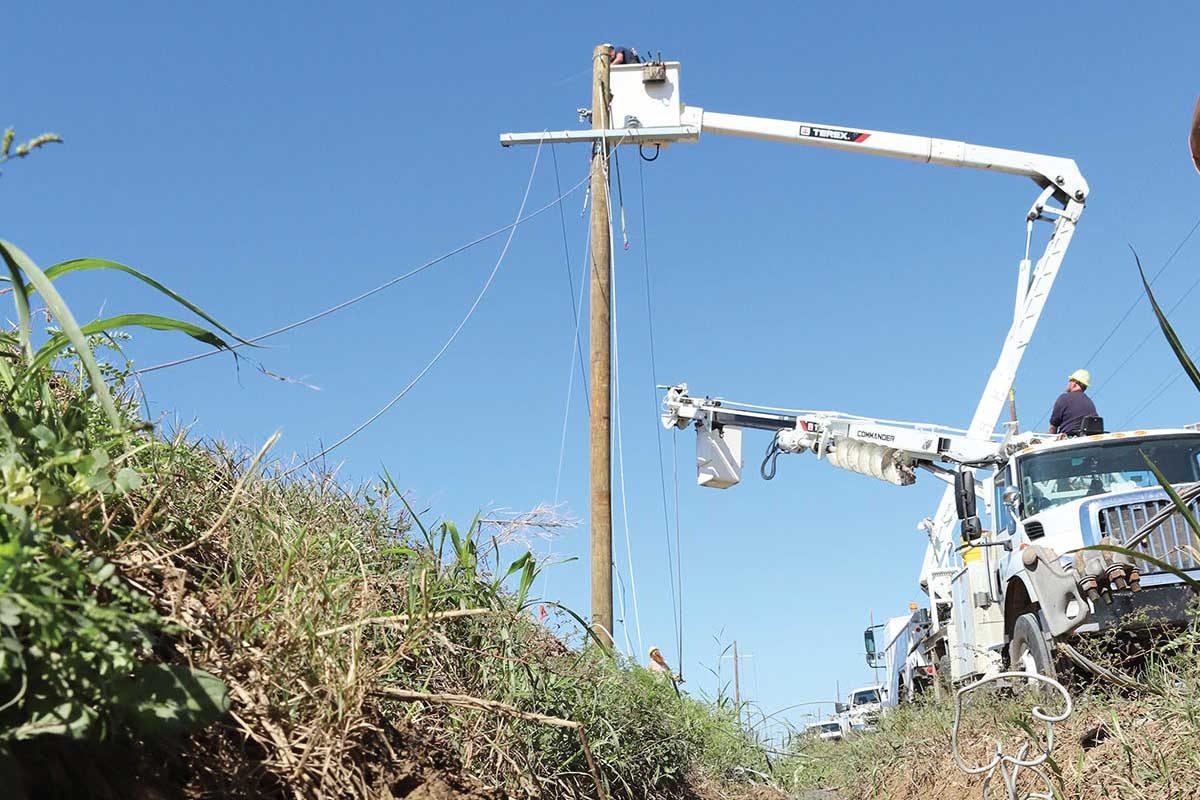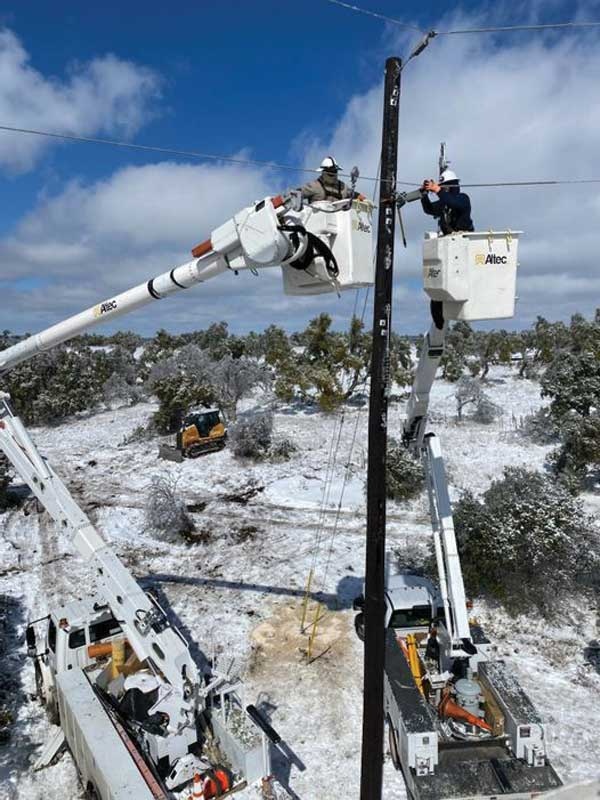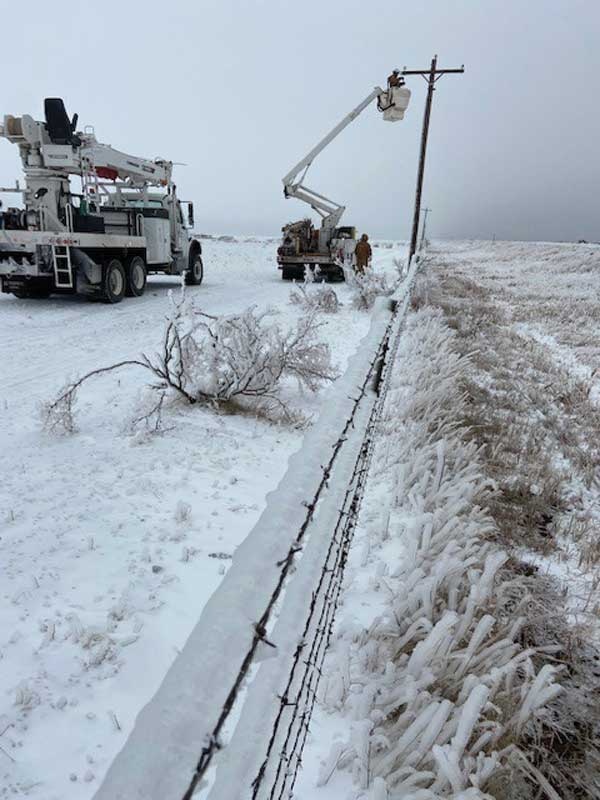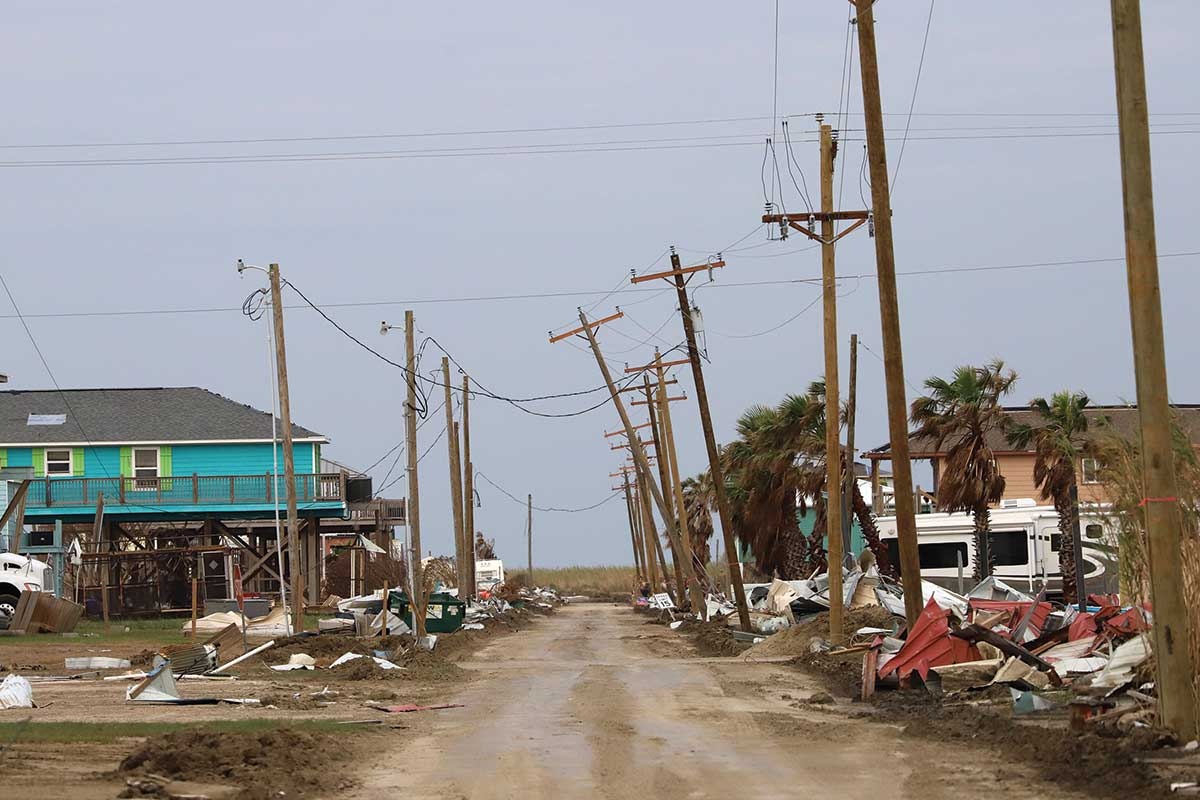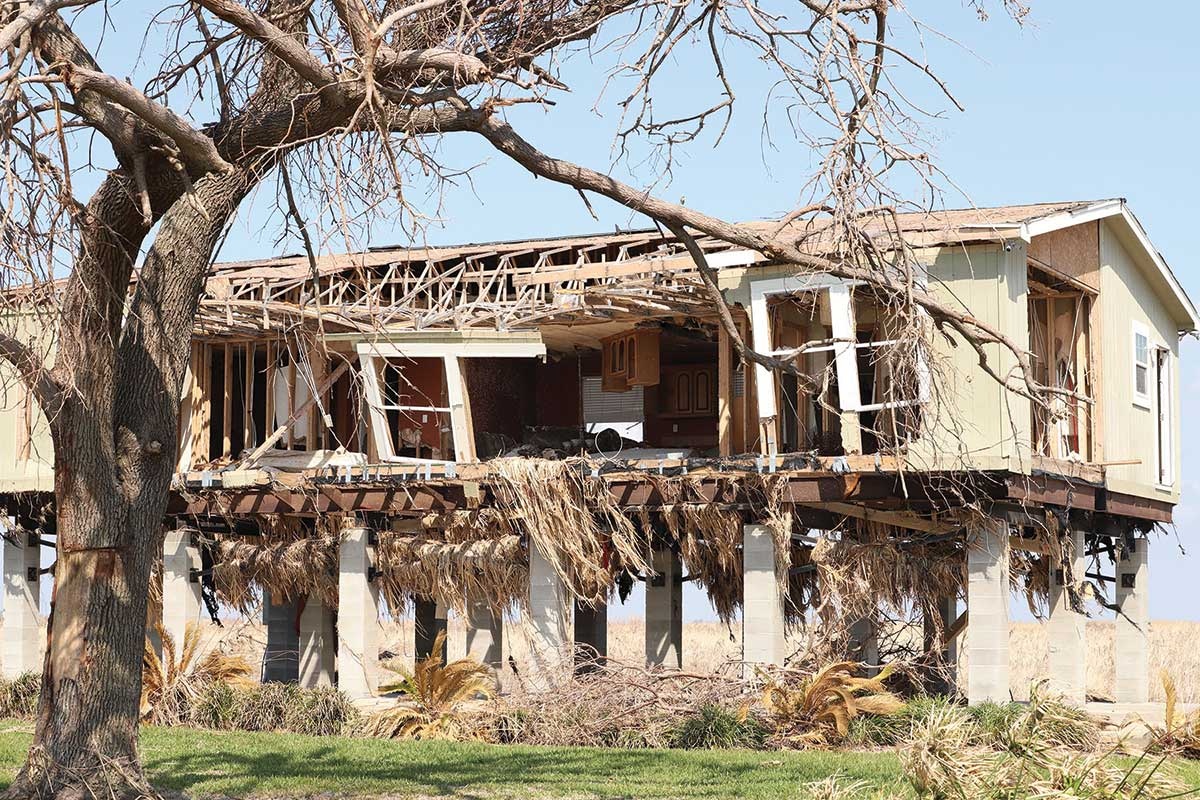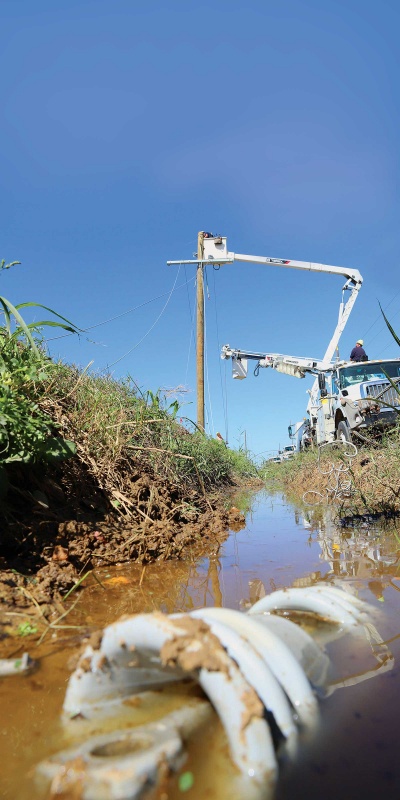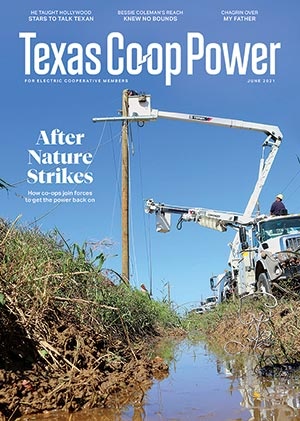It wasn’t the 16-hour days or the searing heat. It wasn’t the meager accommodations—a 100-man tent—or the fact that he’d had only five days off in seven weeks. Speaking from a mud-caked work truck in southwest Louisiana, James Warden didn’t bring up any of those things.
“The hardest part is being away from home,” Warden said. He had just missed his youngest son’s eighth birthday. “When I’m working at home, I still get to see my kids and wife when I come in late at night. I at least get to kiss ’em good night, but here it’s just a phone call.”
The construction foreman for Deep East Texas Electric Cooperative was five days into his second trip in about a month to DeRidder, Louisiana, where he was helping an electric co-op severely damaged by hurricanes Laura and Delta. It was mid-October 2020, and Warden’s crew, based out of San Augustine in East Texas, was setting poles and hanging lines, some of which they’d already reset and rehung weeks before, following Laura. That hurricane knocked out power to Warden’s own home and heavily damaged his own co-op’s lines.
But the day after the lights were back on in East Texas, Warden was in Louisiana. He left his own family to help another family—the co-op family.
In his 24 years as a lineworker, Warden has worked the front lines of major recovery efforts, including after hurricanes Katrina and Rita. But he had never experienced anything like this. He’d never had to miss one of his four kids’ birthdays.
“When we first got here, there weren’t hardly any lines up in the air,” he said. “Their whole system was tore up. It was just wiped. When you drove down the highway, just about every pole you would look at was broke.”
Relentlessly dedicated lineworkers like Warden have for more than 80 years ensured that the lights stay on across Co-op Country, where cooperatives rely on one another when disaster strikes. The full force of that network was on brilliant display last fall, when Laura in August, Hurricane Sally in September and Delta in October ripped through the South, including parts of Texas, killing dozens, displacing many more and destroying electrical infrastructure. And then an unprecedented ice storm tore apart co-op grids in West Texas and the Panhandle.
By the end of last October, lineworkers from every part of Texas had helped restore power for more than a quarter-million co-op members in Texas, Louisiana and Alabama—resetting thousands of poles along hundreds of miles.
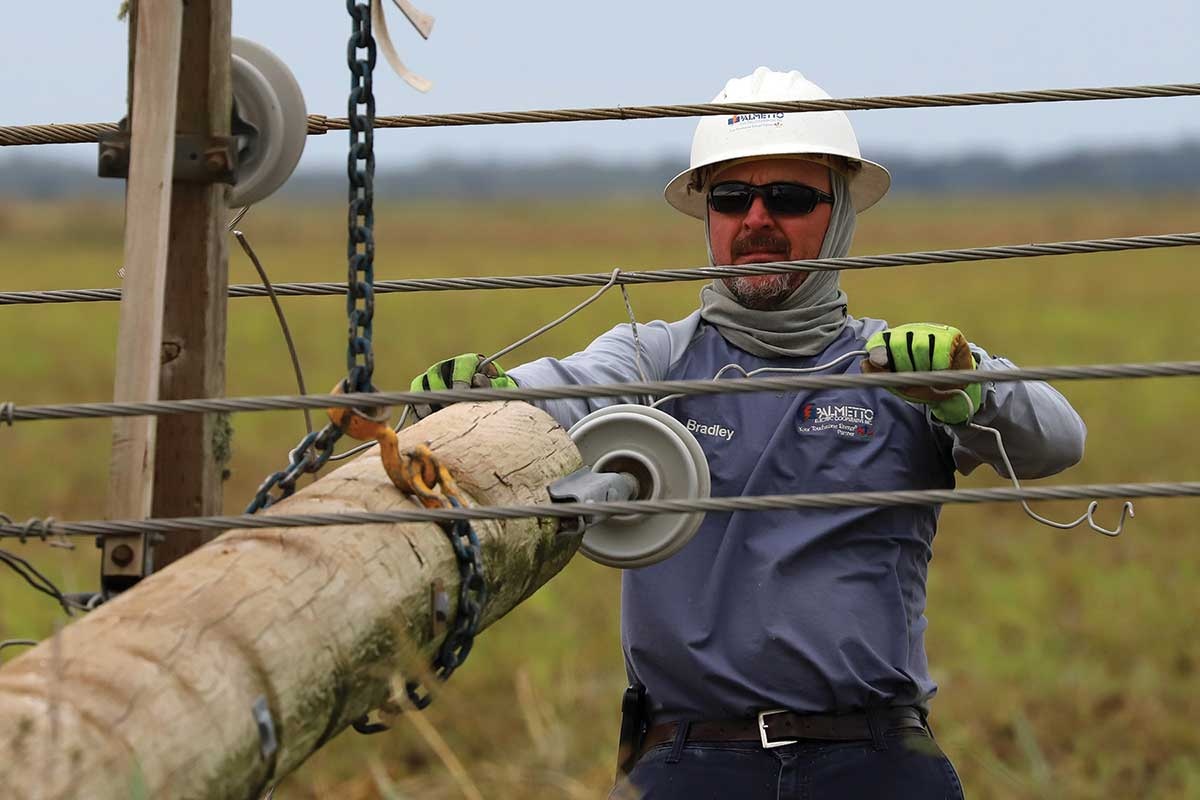
Co-ops follow the Seven Cooperative Principles, including Cooperation Among Cooperatives, through which they seek aid from and offer assistance to fellow co-ops during times of crisis.
Courtesy Sam Houston EC
But lineworkers like Ben Perry don’t measure progress in miles or meters. They measure it in relieved faces.
“That’s probably what will stick with me the most—the people that were there, the hospitality,” said Perry, a foreman for United Cooperative Services, a co-op based south of Fort Worth. Perry, like Warden, was part of a crew dispatched to Louisiana to help Beauregard EC, whose entire electrical system was taken offline by Laura—the strongest recorded hurricane to ever make landfall in Louisiana. The Category 4 storm killed 77 after it made landfall August 27, 2020, packing 150 mph winds.
Laura dealt serious damage to several Texas co-ops but decimated Beauregard EC, prompting a call for help that drew more than 1,200 lineworkers from across the South and Midwest, including Warden and Perry, for a massive monthslong power restoration effort. “We really couldn’t do it without them,” said Danielle Tilley, communications specialist at Beauregard EC.
“The devastation from that storm was unreal,” said Brad Morrow, another United lineworker. “It seemed like everywhere you drove, there were trees and debris, and any sort of house or building was destroyed.”
Twenty Texas co-ops sent help to Jasper-Newton EC, where 90% of that East Texas co-op’s 22,900 meters had no power. General Manager Mark Tamplin was grateful. “Assistance from other cooperatives was extremely critical to the restoration effort,” he said.
“Every time we have a storm at home and it gets real bad, people volunteer to come help us,” Warden said. “Being a lineman, what you’re supposed to do is go help people.”
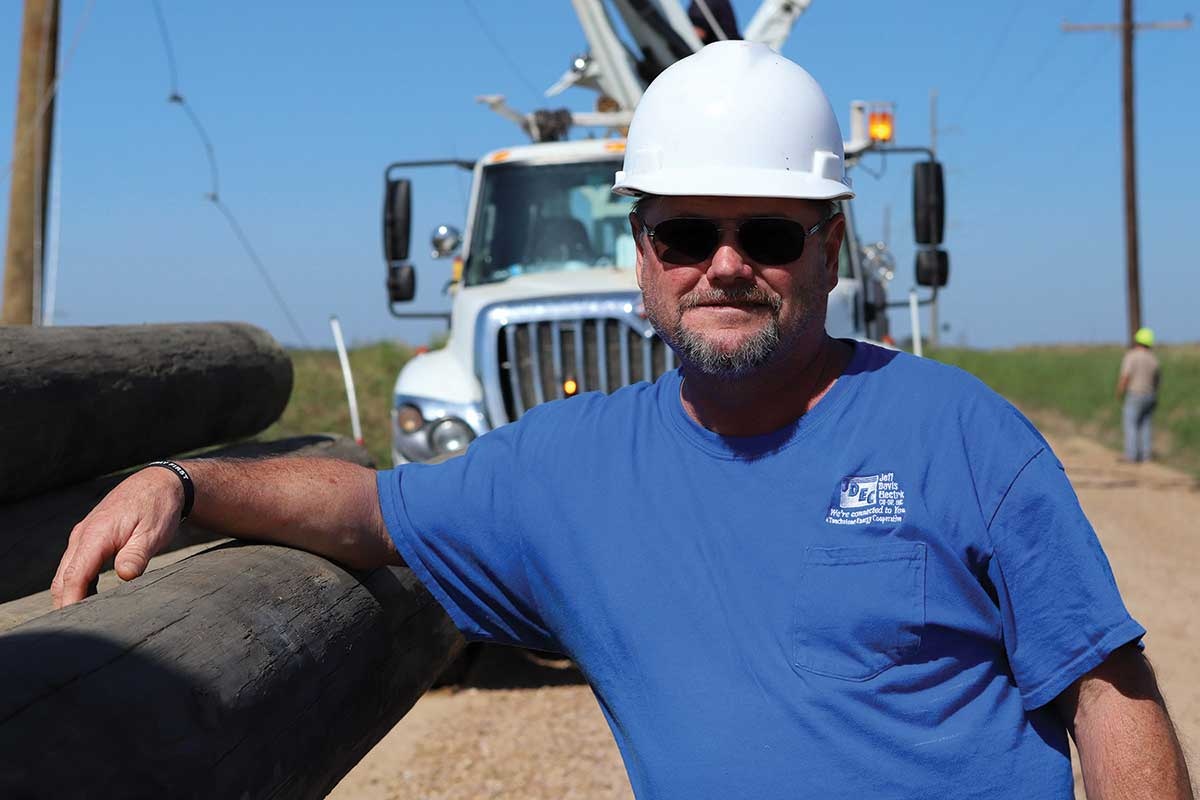
Co-ops follow the Seven Cooperative Principles, including Cooperation Among Cooperatives, through which they seek aid from and offer assistance to fellow co-ops during times of crisis.
Courtesy Sam Houston EC
Cooperation Among Cooperatives, one of the Seven Cooperative Principles that guide all co-ops, ensures that help is just a phone call away when any co-op anywhere needs it.
“Whenever they call us, we’re obligated to go help because there’ll be times in the future when I know we’ll need help,” Perry said. “That’s just what you do.”
Tate Glasscock knows firsthand.
The foreman at Lighthouse EC, based in the Texas Panhandle, also made the trip east after Laura’s onslaught, driving eight hours to spend 10 days helping Jasper-Newton EC.
“That’s what co-ops are for—to help each other,” Glasscock said.
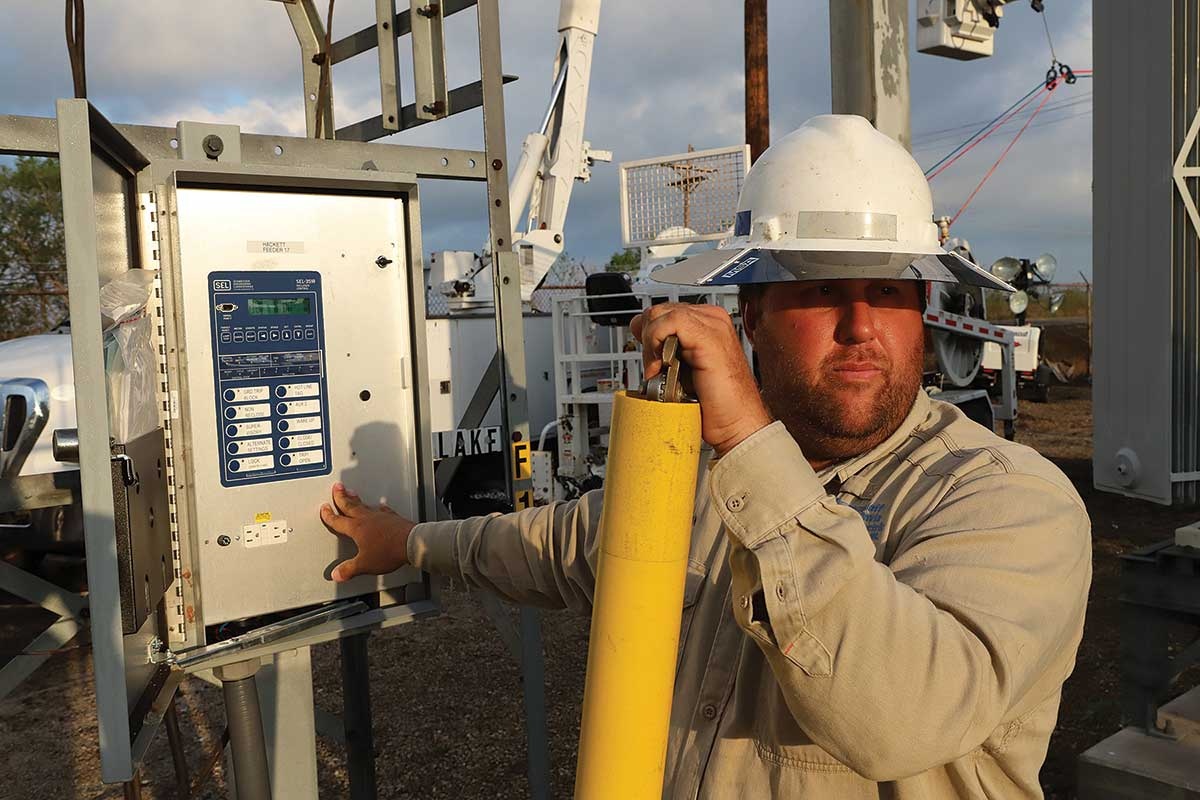
Co-ops follow the Seven Cooperative Principles, including Cooperation Among Cooperatives, through which they seek aid from and offer assistance to fellow co-ops during times of crisis.
Courtesy Sam Houston EC
Just a few weeks after returning from East Texas, Glasscock’s own co-op was hit by a devastating ice storm that snapped upward of 3,700 power poles and knocked offline more than 63,000 meters across 15-plus cooperatives in West Texas and the Panhandle. The October storm coated power lines with half-inch-thick ice, which can add 500 pounds to a single span of line, toppling crossarms, lines and poles across sparse stretches of plains.
Help poured in to the co-ops affected by the ice, which a South Plains EC spokesperson called “the most devastating storm we’ve had in 20 years”; Lighthouse EC general manager Albert Daniel said was “the worst storm to ever hit Lighthouse by all recollections”; and Lyntegar EC called “likely the largest single outage event … in the history of the cooperative.”
Suddenly Glasscock and many fellow first responders were the ones in need of help after they just provided it.
“In my nearly 20-year career, I’ve never seen anything this detrimental to our system,” Glasscock said. “Most of the time it’s in one specific area. This was our whole system.”
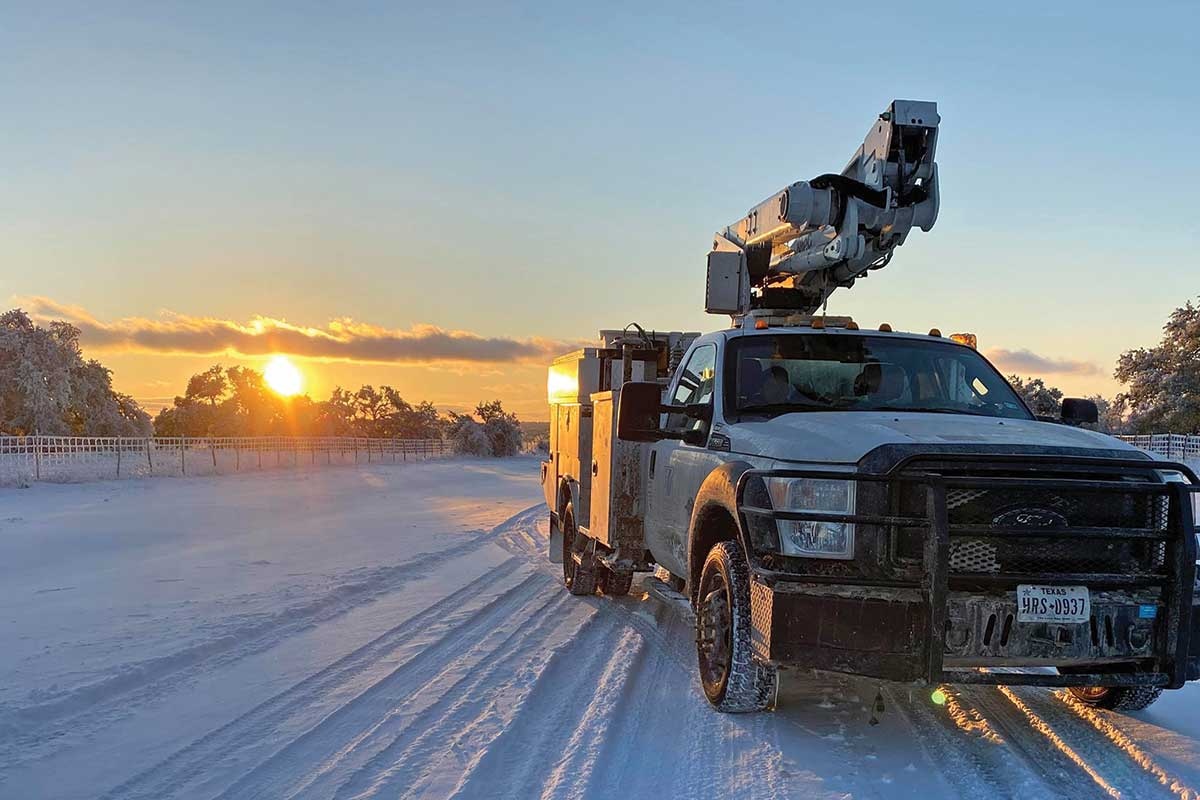
Courtesy Pedernales EC
United lineworkers Perry and Morrow headed west, just weeks after their tireless work out east, joining a major rebuilding effort in the Panhandle.
“Just seeing those guys roll through the gates, I thought, ‘Man, we’ve got help,’ ” Glasscock said. “I knew we were in good shape then.”
Progress was much slower in the Panhandle, where homes can be separated by miles.
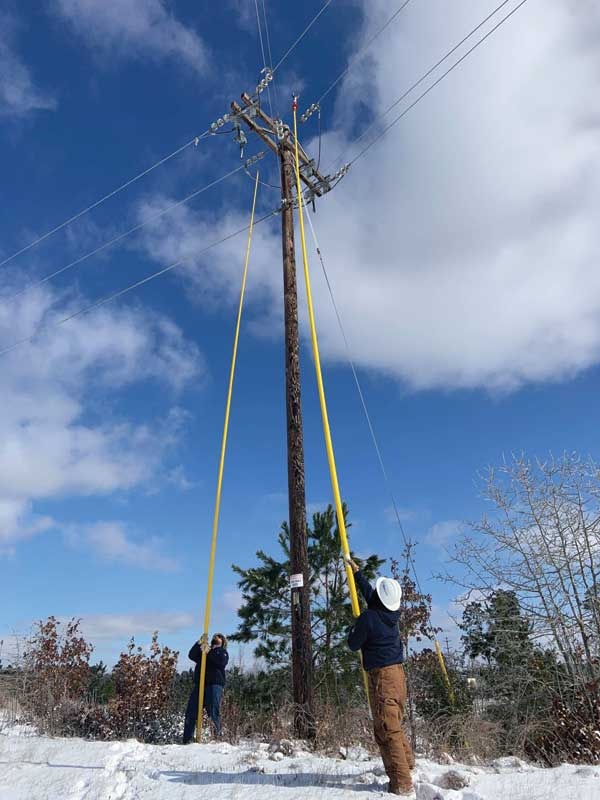
Courtesy Bluebonnet EC
“I believe the first day that we went out, there were 13 or 14 poles that were on the ground that fed one house,” Morrow said. “In Louisiana that might have gotten 30, 40, 50 people on, if not more.” But the payoff was no different. “The relief in people’s eyes and the joy that they experience is the same.”
Between the hurricanes and ice storm, Perry spent about three weeks away from his family over the course of about two months. “I don’t know that I’ll ever forget this year,” said Perry, a 16-year line work veteran. “This has been one of the craziest years that I’ve been a part of in this work.”
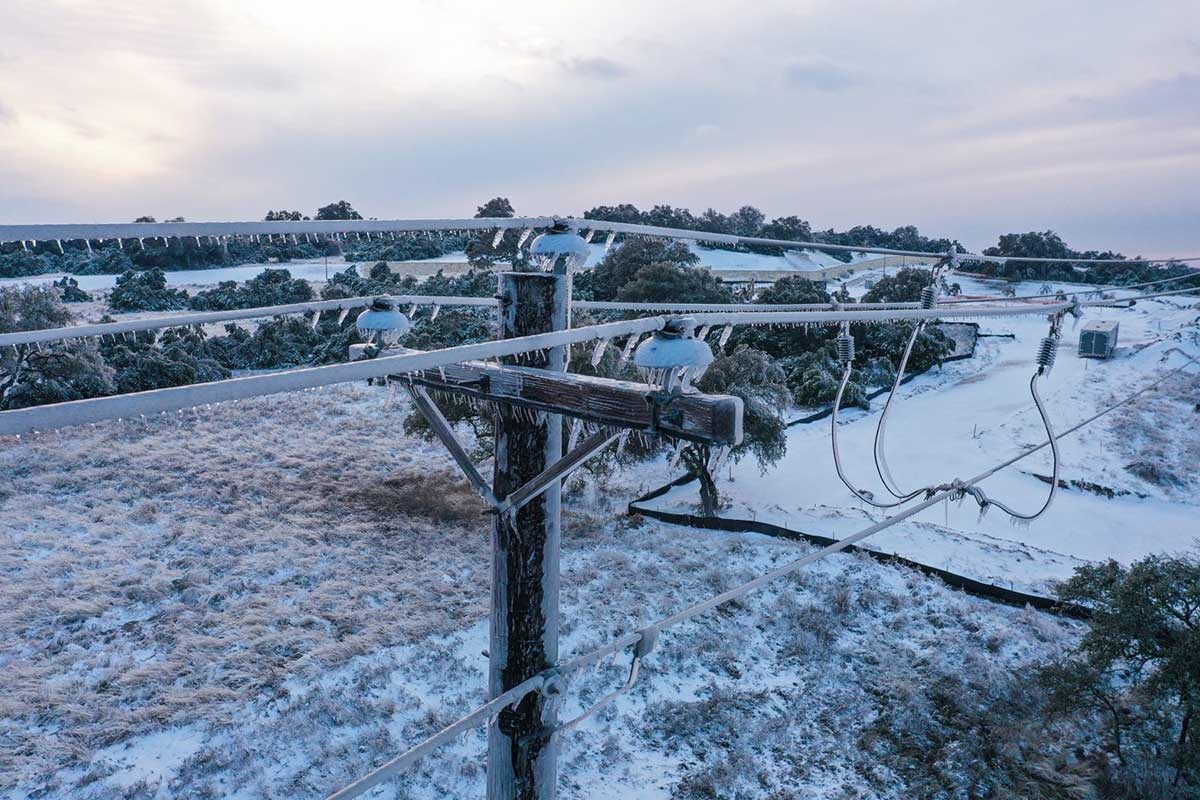
Courtesy Pedernales EC
Those in need kept him going. That was just as true this past February, when co-op members supported crews through an unprecedented polar vortex. Dangerous roads, iced-over lines and poles, and grid-mandated outages made lineworkers’ jobs even more challenging.
“There was the normal fatigue that comes from working so many 12-hour days in a row, but sometimes that was compounded by coming home to a cold house,” said Kendal Fiebrich, a Bluebonnet EC lineworker.
Sympathetic members lent support online and in the field—like a woman in Moss Bluff, Louisiana. She cooked up a meal of gumbo “and any kind of Louisiana fixin’s you could think of,” Morrow said, for linemen from Texas and Missouri who restored her power after weeks of living off a generator.
Strangers united by the co-op family.
“It’s the people who make it worthwhile,” Morrow said. “You’ll never find someone more thankful and willing to help you when you’re there to help them.”
Walking the Lines
After Texas thawed and the lights came back on in February, co-op lineworkers still weren’t done
When February’s polar vortex brought to Texas enough snow, ice, cold and wind to strain every bit of infrastructure, Cody Hansen, a Bandera Electric Cooperative lineworker, parked his bucket truck on the side of a Hill Country road. He was hoofing it.
“The roads were super snowed over. Then instead of patches of black ice, we had all black ice,” he said. “It’s a lot more difficult when you have to walk the lines out and try not to break an ankle.”
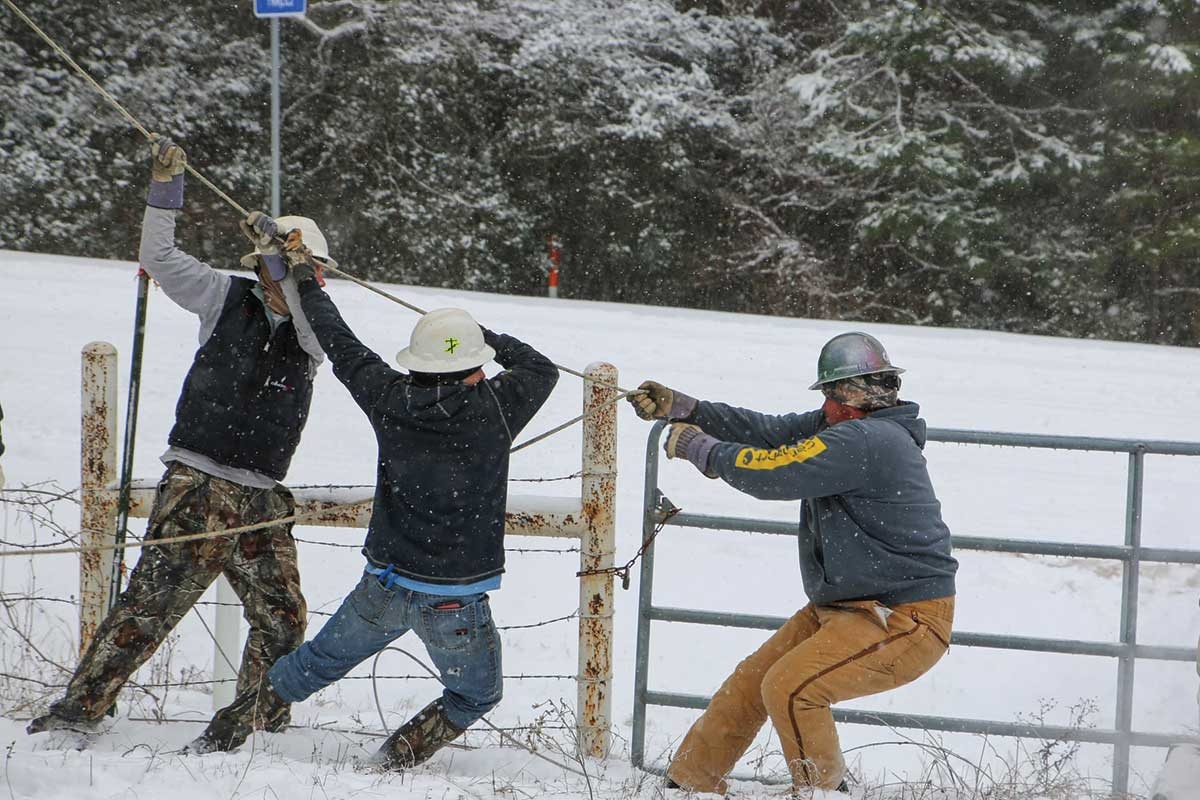
Courtesy Houston County EC
Bandera EC and many of the state’s 65 other distribution cooperatives supplied line crews with foul-weather gear—even if they couldn’t supply their homes with power—and the lineworkers in turn restored power to millions between grid-mandated rolling outages. Those workers faced fender benders, exhausting conditions and 12-plus-hour shifts as they knocked ice from poles and hammered at frozen gates and chains to keep power flowing to co-op members.
But for many, the work wasn’t done when their lights were back on. Not when others still needed help.
About a dozen co-ops sent workers to other cooperatives after ice broke thousands of poles across Co-op Country and residential heating demand overwhelmed other electrical equipment, stretching thin co-ops and crews.
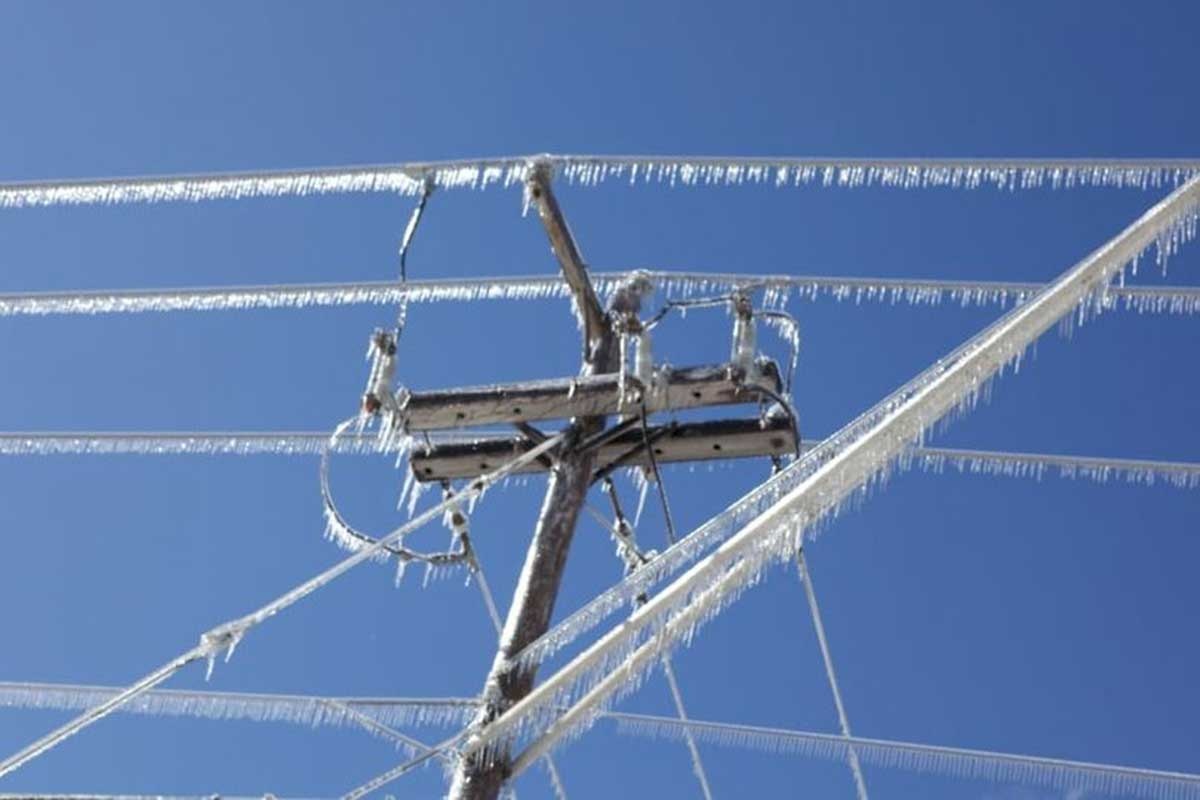
Courtesy HILCO EC
“When our system was on the ground and members were without power, it was reassuring to know we had support from our co-op family,” said Kathi Calvert, general manager at Houston County EC.
Borne out of hardship and guided by the Seven Cooperative Principles, including Cooperation Among Cooperatives, Texas’ electric co-ops worked together, helped along by the very members they serve, to do what they’ve always done.
“Our crews in the field were constantly stuck and having to be pulled around due to the icy conditions,” said Bryan Chandler, operations manager at Heart of Texas EC. “Our members came to our aid with food, fuel and tractors to help pull trucks.”
It took everyone working cooperatively.
“This was definitely the worst winter storm I have worked in,” said Doug Grimm, a 20-year linework veteran for Bluebonnet EC. “We did what we always do: Come together and get the job done.”
Chris Burrows is a TEC senior communications specialist.
